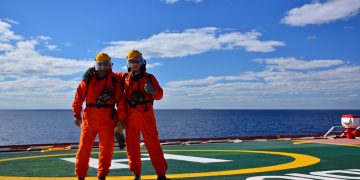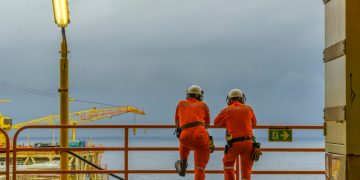During MEPC 75 in November 2020, the IMO approved amendments to MARPOL Annex VI, introducing an Energy Efficiency Design Index for existing ships (EEXI). Subject to adoption at MEPC 76 in June 2021, the requirements will enter into force in 2023. DNV GL analyzed the present and future of EEXI in a recent webinar.
Introduction of the Energy Efficiency Existing Ship Index (EEXI)
The EEXI will be applicable for all vessels above 400 GT falling under MARPOL Annex VI. Guidelines on calculations, surveys and verification of the EEXI will follow and be finalized at MEPC 76.
However, as the EEXI is the extension for existing ships of the newbuilding related EEDI, most procedures will be the same as for the EEDI, with some adaptations regarding limited access to design data, says DNV GL.
[smlsubform prepend=”GET THE SAFETY4SEA IN YOUR INBOX!” showname=false emailtxt=”” emailholder=”Enter your email address” showsubmit=true submittxt=”Submit” jsthanks=false thankyou=”Thank you for subscribing to our mailing list”]
The aim of the Energy Efficiency Existing Ship Index (EEXI) is to measure ships’ energy efficiency. However, different measurements apply for different kinds of ships.
Bulk carriers
For bulk carriers over 200,000 DWT the reduction factor is 15, which increases to 20 for ships under 200,000 DWT.
In addition, corrections will be made for the Common Structure Rules, and a minimum propulsion power requirement will be set for operation in adverse weather conditions.
Bulkers will also have the strictest required EEXI curve of all ship types.

Tankers
For tankers over 200,000 DWT the reduction factor will be the same as bulkers’, namely 15. Moreover, tankers under 200,000 DWT will have a reduction factor of 20.
Additionally, corrections are also expected for Common Structure Rules, as well as a minimum propulsion power requirement for operation in adverse weather conditions.
The difference with bulkers is that a partly shaft motor or shaft generator will be further considered.

Containerships
The EEXI requirements for containerships correspond to 70% of the DWT. However, the challenge is to determine the reference speed, as well as the partly shaft generator.
The reduction factor is also much higher, as for ships over 200,000 DWT the factor is 50, much higher than bulkers and tankers, and reduces as the DWT falls.
General cargo ships
Regarding general cargo ships, there is a large variation around reference line, as there are different designs with different purposes.
Moreover, the correction factor depends on the ship’s dimensions and speed, while it will also consider cranes. Partly shaft generator will also be taken into consideration.
For these ships the highest reduction factor will be 30, for ships over 15,000 DWT.

Gas carriers
As for all other ship types a correction for ice-classed ships will be considered, as well as correction for power and capacity.
An additional correction factor will be considered for ice-classed ships having IA Super and IA giving another 5% improvement.
Here the highest reduction factor is the same as with the general cargo ships, namely 30 for ships over 15,000 DWT.
LNG carriers
LNG carriers were previously considered as gas carriers, with the same reduction factors. However, this has now changed. Specifically, the EEXI requirements for LNG carriers are now considering boil-off gas, as well as the additional auxiliary power needed for reliquefaction system.
LNG carriers have only one reduction factor, which is 30 for ships over 10,000 DWT.
Ro-Ro passenger ships
The correction factor for passenger ships will depend on the ship’s dimensions and its speed.
However, this factor could prevent improvement by limiting the engine power.
What is more, two very important factor that will affect the reduction factor for passenger ships, are their cubic capacity, and the additional hotel load.
Nevertheless, these ships have among the lowest reduction factors, as a ship that is over 1,000 DWT, will have a reduction factor of 5.

Cruise ships
The requirements of EEXI for cruise ships are similar to ro-ro passenger ships. Specifically, the efficiency of the generators and electric motors will be considered, as well as the additional hotel load.
However, the reduction factor is much higher that ro-ro passenger ships, with ships over 85,000 having a 30-reduction factor.
Taking all these factors into consideration, DNV GL recommended that if a ship does not comply with required EEXI, it should:
- Consider engine power limitation
- If speed drop with limited power not acceptable
- Check energy efficiency technologies
Nevertheless, it highlighted that from regulatory side there is an urgent need to review the consideration of energy efficiency technologies, which is planned to start in summer 2021.

Complying with EEXI
In order to comply with the EEXI, ships must at first collect all the documentation needed:
- NOx Technical Files of A/E and M/E
- Lightweight Certificate or Inclining Test Report
- Trim & Stability Booklet
- Model Test Report
- Speed test from Sea Trial Report
- EEDI Technical File (if available)
Then they should analyze potential measures. In order to decide how to achieve the EEXI
target based on previous EEXI calculation, DNV GL suggests operators to consider the following:
- Propulsion optimizations
- Engine optimizations
- Energy efficiency technologies
- Engine Power Limitation (EPL)
- Time of installation
- Cost and payback time of improvement option
- Vessel age
- Speed Loss
The next step is installing the potential measures. To do that, operators must contact the engine manufacturer, who will calculate new SFoC and provide an EPL report.
After that an EPL management plan will be created, and the date for installation needs will be fixed.
The last step is inviting the class for survey.
- After the installation, the next step is the Final EEXI Technical File, which will contain:
- EEXI calculation according to calculation guideline
- EEXI Technical file according to EEXI calculation guideline
- All documentation from improvement measure
After the Final EEXI Technical File is submitted and approved, an onboard survey will take place and a new IEEC will be issued.





























































Hello, there is nothing in this piece abut how EEXI applies to AHTS or offshore supply vessels? Where does one find the reduction factors?
They dont, Offshore vessels are currently exempt
If i am not wrong there are 2 amendments proposed for MEPC 2021. First is EEXI and second is CII rating that is Carbon Intensity Indicator. However CII is applicable to vessels of 5000 GT and above. I guess EEXI is also applicable to vessels above 5000GT. Correct me if i am wrong.
EEXI is applicable above 400GT
What about Heavy Lifts/Heavy Load carriers? Are they exempted?
Yes, they are excluded from definition of general cargo ships. Please check with flag though.
What about Engine drive cargo pumps ?
Do we need to carry out EEXI calculation on those engines?